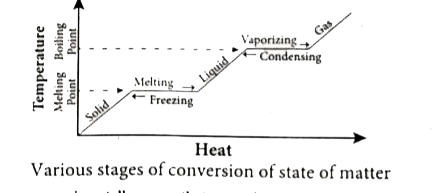What are the changes of state in water? Explain.Solution in Tamil
Any matter around us can be in the three forms : solid ,liquid and gas called states of matter. Depending upon the temperature, pressure and transfer of heat, matter is converted from one state to another and is known as change of state in matter. There are different such processes in the change of state in matter.
For example:
Water molecules are in liquid state at normal temperature. When water is heated to 100∘C, it becomes steam or vapour which is a gaseous state of matter. The process by which a liquid is converted to vapour by absorbing heat is called boiling or vaporization.
The temperature at which a liquid changes its state to gas is called boiling point.
On reducing the temperature of the steam it becomes water again. The process by which a vapour is converted to liquid by releasing heat is called condensation. On reducing the temperature of water further to 0∘C, it becomes ice which is a solid state of water.

The process by which a liquid is converted to solid by releasing heat is called freezing. The temperature by which a liquid changes its state to solid is called freezing point. Ice on heating, becomes water again by absorbing heat, a process known as melting .
Dry ice changes directly to gaseous state without becoming liquid. This process is called sublimation.
Thus, water changes its state when there is a change in temperature.

Topper's Solved these Questions
- BOOK - FULL MARKSCHAPTER - HEATEXERCISE - Exercise (Problems)3videos
HEAT
- BOOK - FULL MARKSCHAPTER - HEATEXERCISE - Exercise (In-Text Problems)6videos
HEAT
- BOOK - FULL MARKSCHAPTER - HEATEXERCISE - Exercise (Answer briefly )8videos
HEAT
- BOOK - FULL MARKSCHAPTER - FLUIDSEXERCISE - Activity1videos
FLUIDS
- BOOK - FULL MARKSCHAPTER - LIGHTEXERCISE - ACTIVITY4videos
LIGHT
Similar Questions
What is the heat in joules required to raise the temperature of 25 grams of 0∘C to 100∘C? What is the heat in Calories? (Specific heat of water =4.18J/g∘C )
03:07View SolutionConvert the following . (i)25∘C to Kelvin (ii)200 K to .∘C
View SolutionDefine conduction band.
03:46View SolutionWhich of the following has more inertia:
03:17View SolutionStand before the mirror in your dressing table or the mirror fixed in a steel almirah. Do you see your whole body?
01:36View SolutionState and explain the anomalous expansion of water.
01:42View SolutionExplain the role of latent heat in the change of state of a substances
02:19View Solutionअवस्था परिवर्तन से आप क्या समझते है? स्पष्ट कीजिए।
View Solutionतरंगो के परावर्तन से आप क्या समझते है ? समझाइये की दृढ़ परिसीमा से परावर्तन की स्थिति में तरंग की कला में का परिवर्तन हो जाता है।
07:44View Solutionపదార్థ స్థితి లో మార్పు జరిగినప్పుడు దాని ద్రవ్యరాశి లో మార్పు ఉంటుందా? ఉదాహరణ తో వివరించండి
03:33View SolutionExplain three states and change in states for matter.
02:44View SolutionExplain the process of change in state of matter by heating or cooling it.
04:07View SolutionAt what temperature in Kelvin scale does water boil? Explain what happens whenwe supply heat energy to water till it changes its state? What is the heat energy called?
02:37View SolutionExplain the Role of Latent heat in the change of state of a substance
01:51View SolutionDefine state of system and explain change of state.
07:33View Solution

